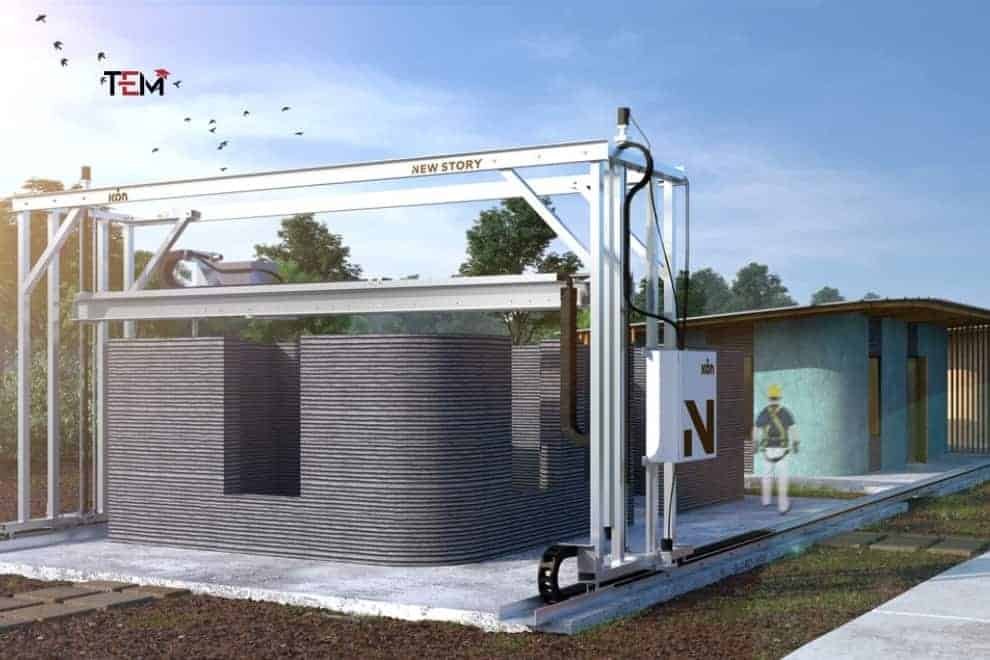The so-called 3D printed house can build in less than 24 hours at a cost of only $10,000. We know how technology has changed our lives over the years. Books, movies, and music have become digitalized. Cars are becoming computerized. The smartphones are more powerful than supercomputers from the mid-90s.
Yet, one major aspect has remained the same and that is housing. Every year there are 60 million more people on earth. Traditional construction cannot keep up with the demand for housing, which is expensive. To solve the problem of affordable housing, it is necessary to build high-quality housing, where traditional construction technologies were lacking.
The main drawbacks of traditional construction methods are the constant use of labor force, enormous construction times, high material costs, the risk of human error, the cost of transport and logistics, construction wastes, and the use of natural resources. In the end, it’s the consumer who pays for it all. But that will all change with the advent of 3d printing which will allow houses to be constructed in a fraction of the time and cost compared to current construction methods.
The best way to illustrate this- is to cover a few companies springing up around the world working hard to implement the technology.
The first-ever 3D printed house demonstration
Apis Cor and its team made headlines in 2017, they printed a house in Stupino, Russia within 24 hours. The houses made up of a concrete mixture that will last for 175 years. They accomplished using the incredible Apis Cor mobile 3D printer. The Apis Cor mobile 3D printer is easy to carry allowing it to transport to the construction sites.
The printer has a stabilization system that can operate without attachment. It takes 30 minutes to set up and requires only two people to operate. The printing zone is 132 square meters. You can print larger structures by moving the printer elsewhere on the construction site. Additionally, you can have two or more printers synchronized with each other.
The company wants to cut the cost of construction to a point where the tiny house can build in cost around $10,000 including windows, doors, electrical wiring, and other bare necessities. The model house has a unique design on purpose to showcase the flexibility of 3D printed houses. With 3D printing, houses will not limit to rectangular shapes. They’ll be able to be in any shape. On top of that, houses will be able to print from a variety of materials and this takes us to Wasp.

Gaia, an iPhone priced home
Wasp is a company based out of Italy and they recently completed a project called Gaia. Gaia is a tiny house constructed at a cost of one thousand dollars using a modular printing system called ‘The Crane Wasp’. The system consists of the main printer unit that can assemble in a different configuration for the construction of larger structures. The system can print structures out of concrete and geopolymers. It can also print from materials found right on the construction site.

The foundation is made up of timber. 3D walls are made out of 25% soil taken from the site, 40% from straw chopped rice, 25% rice husk, and 10% hydraulic lime mixed in a wet pan mill for a house largely made out of the dirt. The inside looks considerably sleek and cozy. This demonstrates how useful and economic 3D printing can be for creating shelters for disaster relief or anyone else who wants a quick crash pad for the cost of an iPhone.
World’s first future 3D printed houses community
So, 3D printing construction will be fast and cheap. When and where will we start seeing people actually live in 3D printed houses?

Netherland uses automated construction methods. The country has a shortage of bricklayers causing high construction costs. The construction company, Van Wijnen is working towards solving the same problem. It is working with the city of Eindhoven to build the world’s first community of 3D printing houses. The community will consist of five houses printed out of concrete. Each house will have a more complex architecture than the before, building off what the team learned from each one. The company is approaching the project as if it was a sculpture garden with a futuristic aesthetic. Based on these renderings the project is going to look incredible once completed. It appears that it is exciting for the locals as well since the waitlist has 20 people for the first house alone.
Hopefully, the project will be successful and we will start seeing other projects like this around the world. And as it stands now it appears housing will finally start to catch up to the rest of the amazing technology in our lives.

2019 has been quite an eventful year when it comes to engaging inventions like 3D-printing. As it has been in practice for some years printing and building useful things. Companies such as New Story and ICON went one-step-closer and built America’s first 3D-printed home for real livelihood. Unveiled in the city of Austin, Texas, the structure has proven itself resilient and cost-effective. Collaborated and stepped-in together, both companies have set out to end global homelessness. Now, 50 more 3D-printed homes are being constructed for poor families in rural Latin America.
We have many spectacles home solutions like green residential smart buildings helping people live eco-friendly. There are not been so great homes that have worked great for rural people. It’s time to demolish the typical and commercial biased homes and feature the future homes that have seen since last year. Ideal for low-income families, 3D-printed homes can be constructed for roughly $10,000 and takes only a day to print.
America stepped for an affordable residential project

New Story has successfully taken a concrete word to build the world’s first 3D-printed community in rural areas of Tabasco, Mexico. Began in December 2019, the company has constructed eight houses so far. The developers hope to complete 50 new houses by the end of 2020.
The rural village families are the most vulnerable and in the lowest income, living on about an average of $3 a day. The area is prone to earthquakes and flooding, which are extremely common.
The estimated time to construct one home is 24 hours where the capacity of the printers allows the team to build two houses at once. While the construction cost is not entirely clear but New Story says it depends on the applicant’s level of income.
“It’s 10 times better than we were a year ago. I am so proud. It is so rare that the-most-in-need of our sisters and brothers globally get first access to advanced technologies and breakthroughs in materials science. We think part of what 3D printing allows us to do is to deliver a much higher-quality product to the housing market at a speed and price that’s typically not available for people in low-income housing,” – ICON CEO and co-founder Jason Ballard told CNN.
An earthquake-proof house that can survive 9.0 magnitude
Since ages, people find technology fascinating as it started impacting our daily lives. Constructing independent homes designs to keep rooted in any kind of threat. Structuring houses with traditional designs need to prepare for any disasters. Having strong, sturdy walls, and a door that we can close at night it’s something fascinating, reminding us of the impossible we ever imagined.

Well, it is a beautiful aspect to see lifestyle thrives and prospers, sadly there have been many disasters that have just passed in recent years. Japan, an earthquake-prone country stands still through making earthquake-proof houses, buildings, and monuments.
Known as one of the most destructive forms of the natural disaster, earthquake drags people slip into its fatal radar. There’s a lot of uncertainty that how a building collapses, but we know it begins with a single point of weakness. To fill the crack, Purdue University researchers with a 3D printing team came with a solution- created a predefined path for the crack to follow and controlling how the damage spreads. During an earthquake, the 3D printed cement paste fills the gap promoting crack whenever it causes damage.


